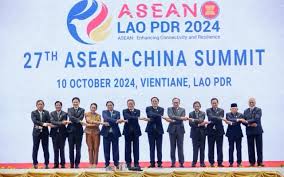
New deal, set to be signed next year, to include integration of digital infrastructure and electronic payment systems
China is set to sign up next year to an updated version of a bilateral free-trade agreement with Southeast Asian nations, consolidating its role in the region by enhancing trade, new energy cooperation and supply chain connectivity.
After a meeting on the sidelines of an Asean regional forum in Laos on October 10, China and the Association of Southeast Asian Nations announced the “substantial conclusion” of Version 3.0 of their free-trade agreement, following nearly two years of negotiations.
The new agreement, expected to be formally signed next year, covers nine new areas, including the digital economy, green economy, supply chain connectivity, and customs facilitation.
It includes the integration of digital infrastructure and electronic payment systems, as well as trade and investment cooperation in green energy, and both sides will encourage their businesses to establish mutually applicable standards.
“We will give priority to standardisation cooperation in fields such as new energy vehicles and electronics,” China’s Ministry of Commerce said.
Beijing aims to strengthen supply chain connectivity with the 10-nation bloc to ensure the free flow of key products and jointly address disruptions.
Christopher Tang, a distinguished professor at the UCLA Anderson School of Management, said that because China’s direct trade with the United States has declined, and its trade with the European Union is “stagnant”, China needs to export more to Asean countries, which have a combined population of 672 million.
“China also wants to dethrone the US dollar as the international reserve currency and replace it with the Chinese yuan,” he said. “Increasing trade with Asean will help to increase the transactions conducted through the Chinese yuan.”
China views Southeast Asia as a backyard, despite disputes over territorial claims in the South China Sea with the Philippines and some other countries.
Major Chinese companies including electric vehicle maker BYD and battery maker CATL have set up or plan to establish factories in Southeast Asia, aiming for smoother, tariff-free access to US and European markets for products assembled outside China.
In Version 3.0 of the free-trade agreement, both sides have, for the first time, included sections on competition and consumer protection in their agreement and are planning to create a committee to enhance cooperation in those areas, aiming to foster a fair business environment for economic exchanges.
“This move is linked to concerns over China’s overcapacity expressed by Indonesia and Thailand,” Tang said, adding that it is a pre-emptive move to stop those concerns spreading to other Asean members.
Indonesia banned the Chinese cross-border e-commerce platform Temu this month, citing concerns that cheap imported products were harming local manufacturers.
In June, Thailand announced a tax on foreign products priced under 1,500 baht (US$45) to protect local businesses from inexpensive goods from China.
“Most Asean governments wish to explore economic opportunities with China, but they don’t want to become economically dependent or a dumping ground for Chinese goods, especially in ways that put undue pressure on their own industries,” said Chong Jia-Ian, an associate professor in political science at the National University of Singapore.
Chong said the maritime disputes in the South China Sea are unlikely to pose major challenges to relations right now, unless the Philippines – which has borne the heaviest impact – seeks concessions as the price of securing economic cooperation.
“Manila may do so at the risk of friction with other Asean members,” he said. “In this regard, some observers may also regard the FTA as a means by Beijing to isolate Manila and further split Asean.”
Source: South China Morning Post
Share: